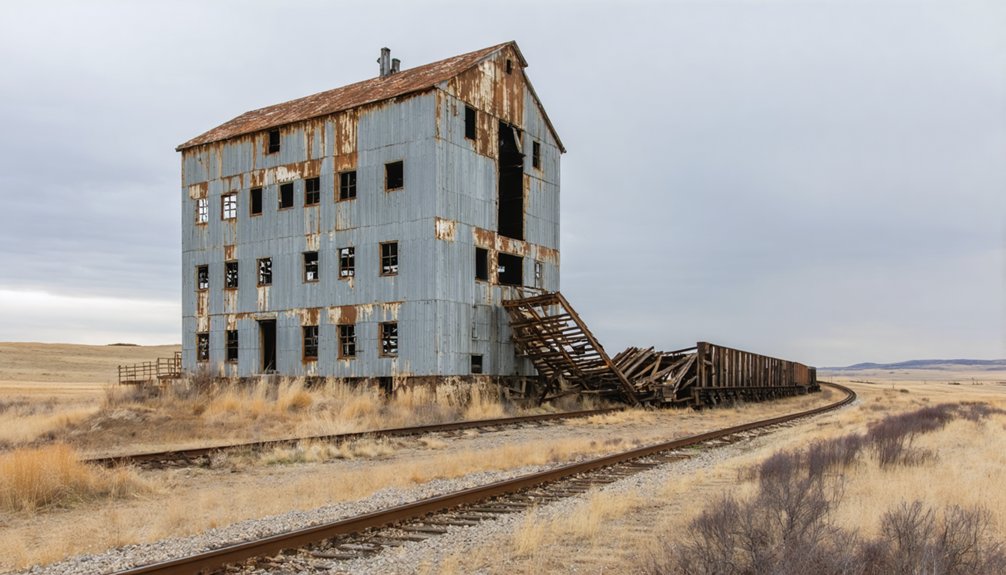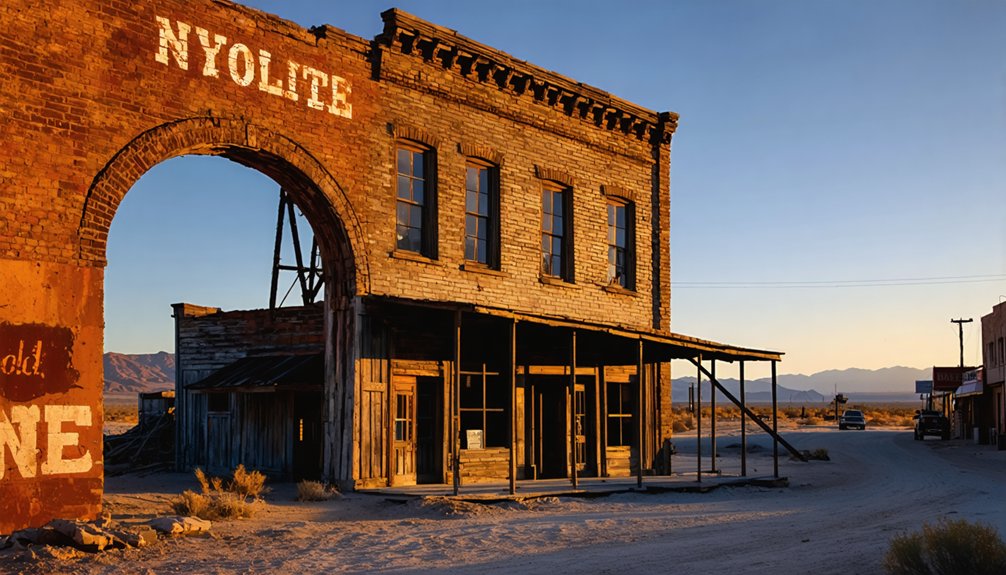You’ll find nearly 4,000 ghost towns across America where railroad prosperity once thrived during the 1850-1916 boom that laid 244,000 miles of track. These communities collapsed when trucking competition, regulatory constraints, and economic depression forced rail abandonment. Today, many towns have transformed through heritage tourism and rails-to-trails conversions generating $229 million annually. Their stories reveal essential lessons about economic diversification and resilience in the face of technological change.
Key Takeaways
- The U.S. railroad industry peaked with 244,000 miles of track by 1916 before declining due to competition from trucks and economic changes.
- Nearly 4,000 ghost towns emerged across America as railroad closures forced businesses to adapt, relocate, or close permanently.
- Towns like Thurmond transformed from coal shipping centers to near-abandoned landmarks after rail service ended.
- The Rails to Trails movement has repurposed abandoned tracks, generating $229 million in annual visitor spending across affected communities.
- Railroad towns demonstrate how single-industry dependence creates economic vulnerability, while heritage tourism offers new revenue possibilities.
The Golden Age: America’s Railroad Expansion (1850-1916)
As America emerged from its early developmental phase, the nation commenced on an unprecedented era of railroad construction that would transform its landscape, economy, and identity. Between 1850 and 1916, the U.S. laid over 244,000 miles of track, creating a vast network that connected previously isolated regions.
This explosive growth fostered revolutionary railroad innovations, including standardized gauge systems implemented by Congress in 1865. By the early twentieth century, the railroad network had become so extensive that no rural point in Iowa was more than eight miles from a railroad. The completion of the first transcontinental railroad in 1869 represented the pinnacle of this achievement, reducing cross-country travel to just six days.
America’s rail revolution delivered uniformity through the tracks and conquered the continent, shrinking vast distances to mere days.
Federal land grants of 129 million acres fueled this expansion, while Chicago emerged as an essential hub with eleven converging rail lines. These government land grants significantly increased property values, with land prices doubling in value following railroad construction.
The rails delivered unprecedented economic integration, creating the world’s largest market, stimulating industrial development, and transforming agriculture while employing more workers than any sector except farming.
When the Tracks Fell Silent: Causes of Rail Abandonment
While the railroad era transformed America into an interconnected economic powerhouse, the mid-twentieth century marked a dramatic reversal of fortune for the nation’s rail system.
You’re witnessing the consequences of a perfect storm that silenced thousands of miles of track.
Competition emerged swiftly from trucking companies leveraging new highways, offering flexible door-to-door delivery that rail couldn’t match. This freight evolution coincided with regulatory strangleholds that prevented railroads from adapting their rates and services. The Interstate Commerce Act capped earnings while costs soared. The U.S. once boasted over 254,000 miles of railway at its peak in the mid-1910s.
Meanwhile, urban decline accelerated as resource-dependent industries collapsed. When mines emptied and factories closed, rail traffic evaporated. The Great Depression further devastated the industry as many rail customers went out of business.
The 1970s bankruptcy of Penn Central and subsequent Staggers Act deregulation in 1980 gave railroads freedom to abandon unprofitable lines—leaving countless communities stranded without their economic lifelines.
Ghost Towns Along the Iron Road: Mapping America’s Lost Rail Communities
Scattered across the American landscape, thousands of forgotten railroad towns stand as silent witnesses to the nation’s rail boom and subsequent decline. Nearly 4,000 ghost towns dot America, with notable examples like Bodie, California and Steins, New Mexico revealing how rail closures triggered community collapse.
For ghost town exploration enthusiasts, interactive resources like abandonedrails.com offer state-by-state maps detailing thousands of miles of abandoned routes. These tools pinpoint where communities once thrived at railroad intersections, documenting their rise and fall. Many of these abandoned towns now serve as important heritage tourism sites, attracting visitors from around the world.
Railroad archaeology reveals physical remnants—depots, grades, and infrastructure—that tell stories of economic dependency. Towns like Harrisburg, Utah showcase how railroad abandonment corresponded with broader economic shifts, leaving behind structures now preserved as historical sites. Google Earth versions provide color-coded routes that help researchers trace how these communities developed along rail corridors.
This allows you to trace America’s industrial evolution through its abandoned rail communities.
Economic Aftershocks: How Rail Closures Transformed Rural Economies
When railroad lines disappeared from rural America throughout the 20th century, they left behind more than just abandoned tracks and empty depots—they triggered profound economic upheaval that reshaped entire communities.
The economic displacement rippled through these regions as businesses dependent on rail service faced difficult choices: adapt, relocate, or close permanently.
You’ll find these impacts manifested in several critical ways:
- Grain producers faced skyrocketing freight logistics costs, forcing shifts to alternate crops or smaller markets.
- Manufacturing declined as businesses requiring rail connectivity relocated to better-served areas.
- Local governments struggled with increased road maintenance costs from heightened truck traffic.
- Employment opportunities contracted, accelerating population loss and further eroding tax bases.
Studies indicate that despite concerns, increased tax revenues from truck traffic often exceeded road maintenance costs by three to five times, creating unexpected financial benefits for some communities.
However, some communities like Meridian, Mississippi demonstrated that passenger rail service can revitalize local economies, transforming empty storefronts into vibrant commercial spaces and attracting significant investment.
Census data consistently reveals this pattern: when the trains stopped coming, economic significance often departed with them, fundamentally altering America’s rural landscape.
Case Studies: Five Railroad Towns That Vanished From the Map
America’s railroad history is etched into the landscape through five particularly compelling ghost towns that once thrived as essential transportation hubs before vanishing into obscurity.
Thurmond history mirrors countless boom-bust cycles, transforming from a 1,000-resident coal shipping powerhouse to a nearly abandoned National Park landmark.
Bodie preservation stands unique, with its gold-fueled prosperity frozen in “arrested decay,” hosting over 100 original structures.
Caliente decline illustrates how centralization devastated former Union Pacific maintenance centers, leaving infrastructure abandoned or repurposed.
Glenrio impact was doubly devastating—losing both its Chicago, Rock Island & Pacific connection and Route 66 relevance to I-40.
Breckinridge agriculture depended entirely on the Blackwell, Enid & Southwestern Railway; when tracks disappeared, so did the town’s economic lifeline, leaving only scattered remnants of its grain-shipping past.
Hunter represents another community established in 1901 that initially flourished with the railroad, reaching a population peak of 443 in 1920 before declining as rail transportation diminished.
A sixth example established in 1895 flourished at the major intersection of Milwaukee Railroad and Northern Pacific, remaining accessible only by rail until roads were constructed in the 1930s.
Rails to Trails: New Life for Abandoned Corridors
As abandoned railroad tracks lie dormant across the American landscape, they’ve become the foundation for one of the nation’s most successful land reclamation movements. This trail revitalization phenomenon has garnered substantial bipartisan support, with $2.8 billion in federal funding allocated nationwide.
You’ll find these projects delivering impressive economic benefits:
- Creating approximately 2,500 new jobs through initiatives like the Great American Rail-Trail
- Generating $229 million in annual visitor spending across connected communities
- Increasing trail use by 45% compared to pre-pandemic levels
- Fostering community engagement with 82% of Americans approving tax investments
The transformation of these abandoned corridors represents more than recreational opportunity—it’s economic revitalization.
The rebirth of America’s forgotten rail corridors creates vibrant community spaces that stimulate local economies and foster connection.
With over 150 multiuse trail networks under development and half of all Americans living near expanding trail systems, these former railroad corridors are becoming crucial infrastructure supporting both physical health and community vitality.
Preserving Railroad Heritage: Saving What Remains

You’ll find a wide array of museums dedicated to preserving historic locomotives, railroad artifacts, and station buildings that would otherwise face demolition.
Community heritage programs, often coordinated by local preservation commissions established in the 1970s, have successfully transformed abandoned depots into cultural centers and tourist attractions.
These preservation initiatives frequently operate through partnerships between nonprofit organizations, government agencies, and railroad companies that provide both funding mechanisms and technical expertise for maintaining America’s rail heritage.
Museum Preservation Efforts
While abandoned railroad towns often fade from public memory, concerted museum preservation efforts have emerged as essential guardians of America’s rail heritage.
Museum funding typically combines foundation grants, community fundraising, and volunteer contributions to achieve preservation goals. You’ll find preservation strategies that include relocating threatened structures—as with the Steilacoom Depot’s planned 80-foot move—and adaptive reuse of abandoned railroad buildings.
These preservation efforts take several forms:
- Conversion of historic depots into educational museums and cultural centers
- Rehabilitation of steam locomotive repair shops as transportation museums
- Operation of heritage railroads as living museums in 48 states
- Implementation of self-evaluation programs like STEPS to strengthen museum offerings
National institutions like the Railroad Museum in Green Bay showcase nationally significant collections while local historical societies maintain smaller but equally important regional artifacts.
Community Heritage Programs
Community heritage programs have emerged as essential mechanisms for preserving America’s railroad legacy, functioning at the intersection of historical conservation and local identity. These programs operate through nonprofits like the Railroading Heritage of Midwest America and Kaw Valley Rail Heritage Conservancy, which leverage membership fees and volunteer participation to sustain preservation efforts.
Organizations can access critical funding through grants from entities like the National Railway Historical Society, which distributes $125,000 annually for preservation projects. With maximum awards of $5,000 per project, these funds enable community engagement through restoration of locomotives, depots, and archival materials.
Heritage education benefits from initiatives like the Historic Railway Structures Survey, which documents significant properties using standardized methodologies. The Colebrookdale Railroad exemplifies successful transformation of Civil War-era infrastructure while supporting job creation and educational opportunities within its surrounding communities.
Lessons From Abandonment: What Railroad Towns Teach About Economic Resilience
Railroad towns across America offer profound lessons in economic resilience, revealing both the vulnerabilities of single-industry dependence and the potential for adaptive recovery.
These settlements demonstrate that economic diversification before crisis strikes provides essential protection against infrastructure abandonment.
Research shows four key resilience factors:
- Communities that repurposed rail infrastructure for new economic activities recovered faster
- Towns that invested in community engagement around revitalization projects saw improved outcomes
- Strategic clustering of alternative services created sustainable economic foundations
- Development of tourism based on railroad heritage provided alternative revenue streams
When rail service disappeared, towns faced harsh economic realities—higher transportation costs, reduced competitiveness, and population decline.
Yet this adversity reveals that economic resilience isn’t merely about preserving existing structures but developing adaptable frameworks that can withstand fundamental changes to economic foundations.
Frequently Asked Questions
How Did Native American Communities Respond to Railroad Expansion?
You’ll find Native Americans resisted fiercely through armed conflict, negotiated strategically when possible, adapted economically where advantageous, but ultimately suffered profound land rights violations and devastating cultural impacts from railroad-enabled colonization.
What Happened to Railroad Workers After Lines Were Abandoned?
You’ll find railroad workers faced displacement, requiring relocation to active rail lines or retraining for other sectors. Economic impact analysis reveals reduced household incomes and increased reliance on government assistance in affected communities.
Did Environmental Factors Contribute to Railroad Town Abandonments?
Like rust crawling over abandoned tracks, environmental factors indeed contributed. You’ll find climate impacts and land degradation from industrial pollution rendered some towns uninhabitable, forcing residents to seek cleaner horizons elsewhere.
How Did Railroad Abandonment Affect Local Education Systems?
You’ll find railroad abandonment devastated local education by slashing school funding through population decline, reducing educational resources, and forcing consolidations that increased student travel times while eliminating community-centered learning environments.
Were There Successful Government Interventions to Save Dying Railroad Towns?
Yes. You’ve seen government policies like state rail purchases and economic incentives through public-private partnerships succeed, though results varied widely depending on local circumstances and commitment to infrastructure investment.
References
- https://news.ycombinator.com/item?id=31017135
- https://core.ac.uk/download/pdf/61066506.pdf
- https://en.wikipedia.org/wiki/Abandoned_railway
- https://rosap.ntl.bts.gov/view/dot/30032/dot_30032_DS1.pdf
- https://humanecology.ucdavis.edu/sites/g/files/dgvnsk161/files/inline-files/EPalacios.pdf
- https://rosap.ntl.bts.gov/view/dot/34121/dot_34121_DS1.pdf
- https://www.abandonedrails.com
- https://journals.oregondigital.org/trforum/article/download/4571/5801
- https://www.loc.gov/collections/railroad-maps-1828-to-1900/articles-and-essays/history-of-railroads-and-maps/the-beginnings-of-american-railroads-and-mapping/
- https://transportation.ky.gov/BikeWalk/2019 Grant Applications/KY Abandoned Railroad Corridor Inventory.pdf



